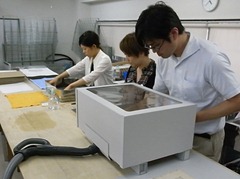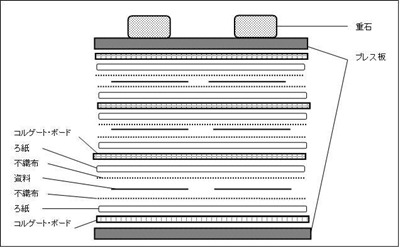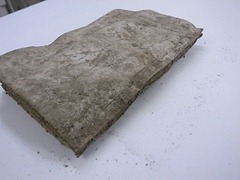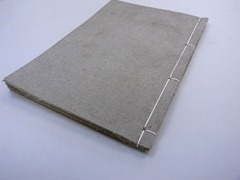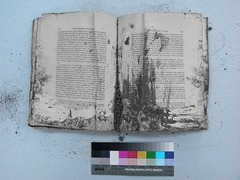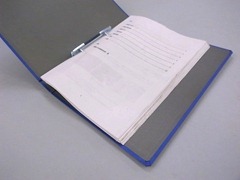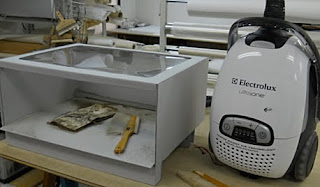保存修復分野の世界的なメーリング・リスト Consevation Distlist へ「海水を含んだ紙への影響と除去法」について下記のように質問を投稿しました。
Paper Damaged by Seawater
From: Kaname Shimada <shimada>
Date: Tuesday, June 14, 2011
As a result of the Great East Japan Earthquake on March 11, 2011, Japanese paper and book conservators are struggling with the rescue and recovery of paper-based objects that have been fully or partially soaked, or moistened with seawater. In the past two months since the earthquake and tsunami hit, the rescue response for photographs, documents, and books by conservators in the affected areas has been very slow.
Even now when over three months passed, these damaged materials are covered with mud and slime, also a continuing mold growth has been reported. However, with ambient temperatures rising, the rescue operation is considering prompt temporary measures such as rinsing and drying until full or partial treatment is available in the near future.
A survey of published conservation literature has not provided any information regarding the recovery of such objects, including information related to the long or short-term effects on paper following exposure to the contents of seawater.
If you have any experience recovering large volumes of paper-based objects that have been contaminated with seawater, or if you can suggest any relevant literature on the subject, please share it withus.
Kaname Shimada
Conservator
Shiryouhozon-kizai Co., Ltd.
これへの回答が2つ、寄せられました。
いずれも、海水の塩が残留した紙が経時後にどのような影響を及ぼすかについては明快な答えはありませんでした。これは当然といえば当然で、AATAやBCIN 等の文献データベースを検索しても皆無で、こうした研究は過去に行われたことがないということになります。この意味では、東嶋健太氏、江前敏晴氏らの「水害被災した紙文化財の塩水を用いた緊急保存法の開発」は先駆的な研究と言え、今後の今後の紙そのものへの残留塩分の影響の研究が期待できます。また、東文救は大学の保存研究者らの協力を得て、東日本大震災で実際に被災した書籍と、同じ書籍で被災していないものの本文紙の比較試験を始めています。いずれ結果をお知らせします。
Paper damaged by seawater
From: David Tremain <datintel>
Date: Monday, June 20, 2011
When I worked for the Canadian Conservation Institute (I am now retired) we were occasionally asked by the Transportation Safety Board of Canada to vacuum freeze-dry aircraft logbooks (and sometimes ship's logbooks) that had been immersed in sea water as a result of an air crash or ship sinking. What we found was that the salt in the sea water was extracted during the vacuum freeze-drying and collected as a lump of ice in the condenser of the freeze-drier.
The documents still smelled of sea water, but airing out afterwards usually eliminated the smell. If there were salt deposits on the surface of the paper these could be brushed off with a soft brush. I would suspect that by now all the documents are dry, so I doubt that there is any point in freeze-drying at this stage. It is also very expensive. Mud, slime and mould can be brushed off under controlled conditions (i.e. in a Level 2 biohazard chamber, or a fume hood, or outside if neither of these is available). I would be leery about rewetting these documents without testing for solubility of inks first; also, rewetting runs the risk of moving the mud and slime around on the paper, and possibly driving them into the paper.
Therefore, if everything is now dry I would suggest brushing and vacuuming dirt, mud, slime, mould using a combination of soft and semi-stiff brushes, and a vacuum cleaner fitted with a HEPA filter. Freezing (at -20 deg. C or colder) should arrest the mould problem. Once the documents are cleaned, test the inks for solubility (if they are soluble the chances are that many of them will already have run). If the inks and the paper are stable then it may be possible to rewet and wash them. Remember, prolonged wetting and mould can severely weaken paper, therefore documents should be supported at all times on Pellon or Reemay polyester support material. If the paper is typical Japanese paper and very fibrous I would suggest using Pellon instead of Reemay since paper fibres tend to stick to Reemay and can be pulled off.
These are just my thoughts, as a former paper conservator, and not those of the Canadian Conservation Institute.
David Tremain
Paper damaged by seawater
From: Barbara Cattaneo <barbara.cattaneo>
Date: Monday, June 20, 2011
The first thought that comes to my mind is that sodium salts may act as oxidants on paper--not really sodium chloride itself, but some other compound already present in paper might that react with sodium. The first thing one would do is to wash the pieces in order to remove sodium. But you should check the presence of sodium after the treatment, too. I guess some sort of tester should exist, in paper strips form, or electrode device (such as pH tester). It is also true that all the degradation reactions are encouraged by moisture, so drying up the paper material should be the first option. Freeze drying, or freeze and then air dry are valid options, too (depending on which inks, adhesives, bindings you are dealing with). I will investigate the effects of sodium in dry material, too and I will let you know.
Barbara Cattaneo
paper conservator
National Library of Florence



